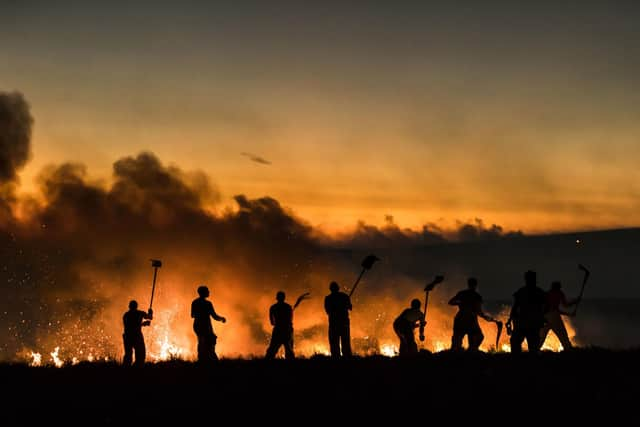National response needed for wildfire threats says university expert as Yorkshire cases spike
Last July, multiple Fire and Rescue Services across the country declared major incidents with London Fire Brigade experiencing its busiest single day since the Second World War.
At the time, experts warned it was a sign of things to come and just in recent weeks in Yorkshire there has been a spike in wildfire cases.
Advertisement
Hide AdAdvertisement
Hide AdOn one Saturday night a fortnight ago, North Yorkshire Fire and Rescue were called to a small fire in a field near Scarborough shortly after 8.30pm. At Embsay Reservoir, Skipton firefighters were called to a large campfire on very dry ground, while in Selby a small fire had been set deliberately by youths.


By 10pm, a bonfire was sighted on Glaisdale Moor, close to moorland, then shortly after midnight an area of grassland at Glaisdale Rigg was ablaze.
Crews found a 'second seat' of fire just south of this one, measuring 10m square. A bigger blaze broke out at Danby Beacon meanwhile, across an area the size of an Olympic swimming pool.
In West Yorkshire, a large heather blaze broke out in Keighley near Harden Moor in June and just days before, another wildfire was reported on the moor itself.
Advertisement
Hide AdAdvertisement
Hide AdIn an article for the University of Manchester, Dr Gareth Clay writes that due to the effects of climate change on weather conditions, wildfire season could start extending into Autumn.
He said: “The impact of climate change suggests we will likely see an increase in the number of days above critical ‘fire danger’ thresholds, which are set by a fire weather index to define danger, with the potential for the wildfire season to extend into autumn.”
For many decades, the United States, Canada and Australia have had Fire Danger Rating Systems in place which assess fuel and weather conditions to provide estimates about potential fire behaviour under specific conditions. This information is used by land managers, planners and emergency services to inform decision making.
England and Wales rely on the Met Office Fire Severity Index (MOFSI) which is based only on meteorological data.
Advertisement
Hide AdAdvertisement
Hide AdResearchers at The University of Manchester are leading a major project to develop new insights into the location and condition of important fuels, how they react to different weather conditions throughout the year and quantifying how flammable they are.
This would then allow for a tailored UK fire behaviour model to be produced.
Dr Clay added: “The next step in this journey will be to take the findings from our research and work with partners to develop an operational FDRS in the coming years. These partners include government departments, like the Home Office, Cabinet Office, and Department for Environment, Food and Rural Affairs, the Met Office, wildfire forums across the UK and landowners and managers.”
“This system would allow for management decisions to be taken in advance of heightened fire conditions, such as stepping up additional Fire and Rescue Service crews, modifying land management practices when the danger is high, or increased public-facing messages, including warning signs at popular recreation spots.”
